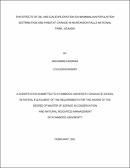The effects of oil and gas exploration on Mammalian population distribution and habitant change in Murchison Falls national Park, Uganda
Abstract
Uganda discovered petroleum deposits in commercially viable quantities in 2006. Most areas such as Murchison Falls National Park where petroleum has been discovered overlap with wildlife and nature conservation with high biodiversity and sensitive ecosystems. Oil development could destroy mammal habitats, disrupt animal abundance and people’s lives if not well planned. This research aimed to find out the current status of mammals and their habitats as well as the social perception of oil and gas operations in the park five years after completion of exploration and restoration of oil pads. The specific objectives of the study were to; determine the change in mammal habitats in relation to oil and gas exploration, determine the effects of post exploration oil and gas infrastructure on the abundance and distribution of mammalian population and determine the social perception of the people living in and around MFNP regarding oil and gas operations in the protected area. The study used observation and survey methods for data collection. It involved measuring vegetation frequency index, vegetation relative abundance and vegetation diversity in oil pads and control areas. The study recorded grasses, shrubs and tree plant forms using different size quadrats along a 60m line transect. The quadrat sizes were (1x1m) for grasses, (5x5m) for shrubs, (10x10m) for trees. The number of quadrats and transects per site under study were (8 x4) in total. Indirect and direct mammal counts were conducted by walking along a 2km transect while recording physical mammals, footprints, fecal pallets, wallowing grounds, fur, palm seeds and kobleks. A social survey was conducted by administering 50 questionnaires to key informants to determine the perception of the community about oil and gas exploration. The key informants included 10 UWA administrators, 10 oil and gas workers and 30 local people from Nwoya (15) and Pakwach (15) Districts. The study recorded uniform and non-uniform plant species and the mean vegetation diversity of (1.9±0.058) in oil pads and (1.71±0.120) in control areas. The study identified 31 different plant species and among these 7 plant species were recorded in oil pads, 8 in control areas. 16 types of these plant species were recorded in both oil pads and control areas. The results indicate a non-significant difference in the vegetation relative abundance and diversity between oil pads and control areas. The study counted seven mammal species and the results show a non-significant difference of the mammal’s population abundance and distribution in oil pads and control areas. The survey participants suggested improvement in areas of oil waste management, noise, animal disturbance and displacement. The local people fear that the park is at risk of losing its biodiversity. Further studies can be carried out using different methodologies such as chemical soil analysis, animal tagging, and genetics to further determine if there are any effects on mammals as a result of oil exploration activities. It’s further recommended that similar studies could be conducted on other former oil pads in the national park to get the true representation of the whole ecosystem.

